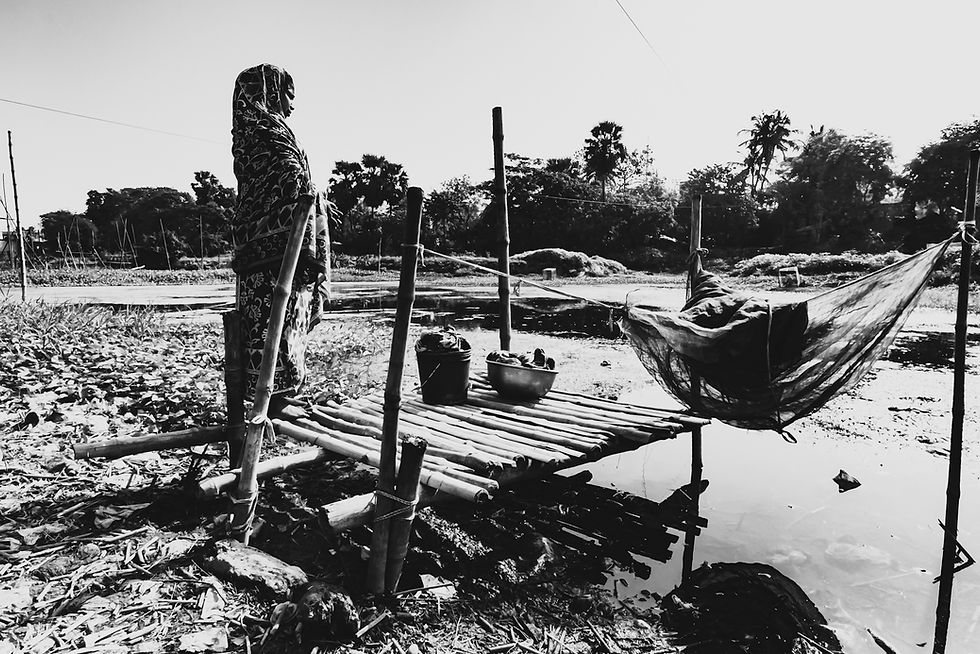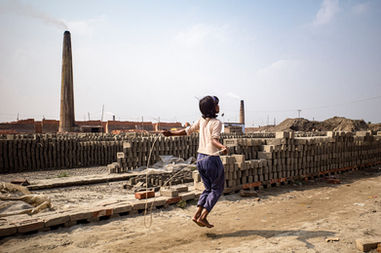
PICTORIAL STORY
April 12, 2024
MUD
Reflections on an Endangered Legacy
Photography and Story by Dedipya Basak
Introduction by Melanie Meggs
Dedipya Basak stands at the intersection of academia and artistry, wielding his camera as a tool for societal transformation. Hailing from Kolkata, his educational journey through Ramakrishna Mission and Jadavpur University laid the groundwork for a career marked by both scholarly rigor and creative vision. Since 2015, he has been the recipient of various research grants from the Ministry of India, allowing him to focus on fields as diverse as Happiness Economics, Human Culture, and Gender Economics over a span of seven years. Dedipya’s research has garnered acclaim in academic circles, illuminating crucial facets of human society, through publications in numerous esteemed journals.
The seeds of Dedipya’s photographic passion were sown in childhood, nurtured by the thoughtful gift of a camera from his father, himself a photographer. Though his father’s physical presence may have faded, his legacy endures within Dedipya, driving him to capture the essence of the human experience through his lens. Unlike his father, Dedipya’s early forays into photography were exploratory, lacking a clear direction or purpose. Yet, over time, his camera became a tool for social commentary, a means of amplifying the voices of the marginalized and downtrodden, in alignment with the teachings of Ramakrishna Mission. Dedipya was a student of Ramakrishna Mission for twelve years.
“I mainly focus on showing one particular theme with different points of view. It helps me to build up the story firmly and remind my viewers constantly of the central objective of the project. A constant change in POV (point of view) makes my images versatile and the sequence becomes engaging for my viewers,” Dedipya reflects on his photographic approach.
Central to Dedipya’s approach is his ability to adopt varied perspectives, each frame telling a nuanced story of the human condition. Dedipya navigates communities characterized by reticence and delicacy, often situated in regions marked by extreme climate conditions and remote from urban centers. In such contexts, his network of contacts becomes indispensable, serving as gateways into these communities. These connections act as vital catalysts for his projects, facilitating group interviews, assisting in securing accommodations when needed, and offering support in myriad other ways. Dedipya acknowledges that without the invaluable assistance of these contacts, his ability to produce impactful bodies of work would be severely constrained.
In 2021, Dedipya resolved to embark on a professional journey in photography, aiming to integrate his research into visual storytelling at the International Center of Photography in New York. There, amidst a cohort of talented artists and mentors, he delved into the intricacies of street photography, visual storytelling, and documentary practice. His dedication and talent were duly recognized in 2024 when he was honored with the ICP Directorial Fellowship. Throughout his studies, Dedipya honed his expertise in subversion, human culture, photographic editing, and the art of visual storytelling, shaping him into a multifaceted and impactful photographer.
When asked about his educational experience in the United States and the valuable lessons learned, Dedipya shared, “The United States is the country of braves. If you have clarity regarding your work, then they will welcome you with heartiness. At ICP, we have some of the faculty members who are the best in their respective practices. They have differences in their opinions, photographic style, and many other ideas. But all of them are good humans. Their down-to-earth nature is the most valuable teaching for me. I strongly believe that apart from my publications in different countries, adapting their humanitarian view in my life is my greatest success.”
It is this blend of technical skill and compassionate storytelling that defines Dedipya’s work. In 2022, while at ICP, Dedipya successfully concluded his inaugural documentary project titled “Sidewalk.” This project delved into the intricate tapestry of Kolkata’s pavements, offering a captivating visual exploration. The compelling imagery garnered widespread recognition, finding its way into various international publications.
During the same year, Dedipya embarked on a new documentary venture titled “MUD.” This project delves into the narrative of an ancient lake, aged 800 years, facing demise as a consequence of escalating global warming. Dedipya is passionate about sharing this impactful story, emphasizing its relevance and urgency in today's world with The Pictorial List’s audience.
-min.jpg)
“MUD” encapsulates a visual journey documenting the lives of 70,000 impoverished fishermen residing around Lake Bhandardara, an 800-year-old lake in West Bengal, India. Tragically, this historic body of water is facing imminent demise as a result of severe global warming.
From the 12th century until the conclusion of the British Raj in India, Lake Bhandardara played a pivotal role as a prominent trade route connecting with Southeast Asia. Moreover, it stood out as one of the few natural habitats for riverine pearls, thereby bolstering India's treasury with valuable foreign currency. Linked to the renowned Padma River, this lake teemed with natural plankton, establishing it as a prime feeding and breeding ground for numerous marine species. Consequently, local fisheries cooperatives reaped substantial daily earnings, amounting to approximately INR 15,000 even a quarter-century ago.
Over the past twenty-five years, however, the situation has undergone a dramatic shift. Unprecedented climate changes have led to the alteration of Padma's course, disrupting the lifeline of the lake. As a result, the waterbed is dwindling, weeds are proliferating throughout the lake, and marine life is diminishing steadily. Consequently, the inhabitants of the surrounding twenty-one villages find themselves in dire straits.
“MUD” is an ongoing extended documentary investigation of that glorious past, collapsing present, and dubious future.
This poignant reality struck a chord with me deeply. Even today, when I close my eyes, the most repeated sentence by every villager resonates in my ear - “The lake is dying. Can you help us?”
To commence the project, I conducted thorough research. During this process, I discovered an environmentalist from Kolkata who had previously conducted primary research on the lake. After multiple meetings with him, forging a connection that led me to individuals still residing in various villages surrounding the lake. Building a robust network with the locals, I pinpointed the existing research gap within the project and began my investigative work.
Spanning over 50 kilometers in length, the lake remains largely unexplored, with only a few sections untouched by human influence. Despite my efforts, I have yet to complete visits to the entire expanse of the lake. Through my numerous visits to the lake, I've diligently collected information from the local fishermen. They reminisce about the bygone era as the ‘golden period’ of Lake Bhandardara. Regrettably, the current situation paints a starkly contrasting picture. The waterbed is desiccating due to rampant global warming, while weeds proliferate unchecked. With groundwater resources dwindling, local farmers resort to utilizing the residual lake water for jute farming, leading to a rapid deterioration in water quality with each passing year.
My photographs capture the daily struggles of the villagers residing around Lake Bhandardara. Through these images, viewers can discern the residents’ efforts to adapt to the current state of the lake. Despite the challenges posed by its deteriorating condition, they resiliently seek opportunities to address their everyday problems, finding solace in prayer amidst their trials.
The central issue of my project serves as a recurring motif throughout my photographs — the impending demise of the lake. Interspersed among these images are ‘no lake’ shots, providing a momentary pause or temporary divergence from my central theme. Upon resuming, I skillfully compose stylistically varied images of the lake, each offering a unique perspective on its plight.

Documenting the lives and challenges of marginalized communities, Dedipya Basak captures their essence through his photographic essays. Surprisingly, each return home yields a plethora of positive insights. In this project, Dedipya’s primary revelation was centered on ‘their hope.’ Despite the lake’s dire state, they continue to fish, fueled by a steadfast belief that conditions will ameliorate, and future generations will experience the prosperous era of Lake Bhandardara, reminiscent of three decades ago.
Being deeply connected with one’s documentary work can evoke a myriad of emotions. Dedipya’s journey epitomizes this profound connection, where academic inquiry converges with artistic expression to illuminate pressing societal issues. As he navigates the complexities of his projects, Dedipya shares insights into his approach to maintaining boundaries and cultivating a balanced, mindful, and safe work ethic.
“For me, it is like meditation. I am involved in the entire process, but I am not attached to it. Though the theme of the project is always very sensitive from a humanitarian point of view, yet I keep myself consciously distant from that event – I become like a cinema screen where one can play any kind of movie, but it doesn't affect the screen. That is how I set my boundaries and create a balanced, aware and safe work ethic for me.”
As Dedipya Basak’s voyage unfolds, his photographs stand as poignant evidence of the resilience and hope inherent in the human spirit. With a mindful and balanced approach, he traverses the emotional terrain of his documentary work, providing viewers with profound insights into our collective human experience.

The views, thoughts, and opinions expressed in the text belong solely to the author/s, and are not necessarily shared by The Pictorial List and the team.












































